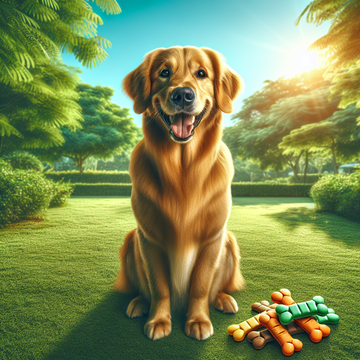Feeding Treats to your pup Safely and Responsibly
As pet owners, rewarding our furry friends with treats is an enjoyable experience. However, treating our dogs comes with the responsibility of ensuring their safety and well-being. In this article, we'll go into a few crucial aspects of treat safety, guiding pet owners on the importance of responsible treat feeding, avoiding potential problems, and creating a healthy and happy relationship with our canine companions.
Portion Control
While treats can be a delightful addition to a dog's diet, balance is key. Excessive treat consumption can contribute to unhealthy weight gain and associated health issues, such as obesity, diabetes, and joint problems. To ensure healthy moderation, consider the following:
Follow Feeding Guidelines
Follow the recommended portion sizes provided on the treat packaging and consult your vet for personalized advice based on your dog's size, breed, and activity level.
Account for Treat Calories
Treat calories should be factored into your dog's daily calorie intake to avoid overfeeding. This is especially important for dogs on specific dietary plans or weight management programs.
Be Mindful of Treat Ingredients
Understanding the ingredients in your dog's treats is essential for their overall health. Choose treats with high-quality, wholesome ingredients, and be cautious of additives, preservatives, and potential allergens. Consider the following tips:
Read Labels
Take the time to read and understand labels. Look for treats with minimal, ingredients that are recognizable, and avoid those with excessive artificial additives.
Check for Allergens
If your dog has known allergies, carefully inspect treat labels to ensure they do not contain allergens that could cause harmful reactions to your pup.
Avoid Harmful Ingredients
Steer clear of treats that may contain ingredients like xylitol, chocolate, onions, garlic, and other substances that are toxic to dogs. In general, most treats won't include these things, but it doesn't hurt to be on the safe side.
Watch Out for Treat Size and Texture
The size and texture of treats can impact your dog's safety, particularly when it comes to choking hazards and digestion. Keep the following in mind:
Appropriate Size
Choose treats that are appropriate for your dog. Avoid treats that may be choking hazards such as treats that are too small or big for them to adequately chew.
Texture Matters
Some dogs may have difficulty chewing hard or crunchy treats, especially as they age. Consider the texture of treats. You may choose softer options for senior dogs or those with dental issues.
Monitor Chewing Habits
Keep an eye on your dog while they are enjoying a treat, especially if it's a new type or size. If your dog struggles or appears uncomfortable, consider a different treat.
Be Wary of Treat Frequency
Consistency in feeding is crucial to prevent overindulgence and maintain a balanced diet. Establish clear guidelines for treat consistency and avoid the temptation to offer treats too frequently.
Set a Treat Schedule
Designate specific times for treats, such as during training sessions or as occasional rewards. This helps prevent excessive consumption throughout the day.
Use Treats Purposefully
Treats are an excellent tool for training and positive reinforcement. Instead of using treats as a default, reserve them for reinforcing good behavior and obedience to keep them special.
Monitor for Allergic Reactions
Just like humans, dogs can develop allergies to certain foods. When introducing new treats or changing your dog's diet, be wary of signs of allergic reactions, including:
Itching or Redness
Persistent scratching, redness, or inflammation in the skin may indicate an allergic reaction.
Digestive Issues
Diarrhea, vomiting, or changes in stool can be signs of food allergies or sensitivities.
Behavioral Changes
Unexplained changes in behavior, fatigue, or irritability may be linked to an adverse reaction to a specific ingredient.
If you observe any of these symptoms, consult your vet to determine the cause and make necessary adjustments according to their guidelines.
Conclusion
Feeding treats to your dog is a wonderful way to strengthen your bond and reward positive behavior. By practicing portion control, choosing treats with high-quality ingredients, considering size and texture, regulating treat frequency, and monitoring for allergic reactions, you can provide your dog with treats safely and enhance their overall happiness. Treat time should be a positive and enjoyable experience for both you and your canine companion, and with the right approach, it can contribute to a lifetime of joy and well-being.






